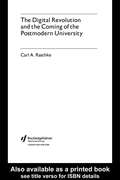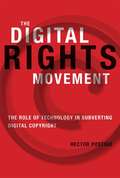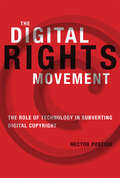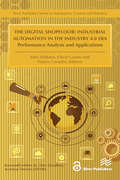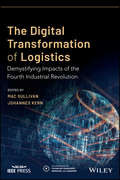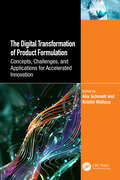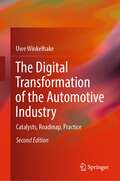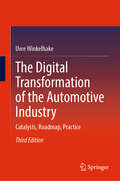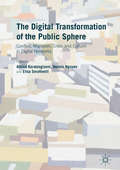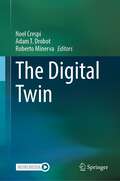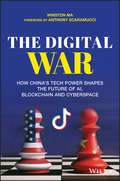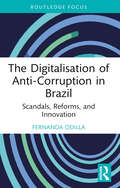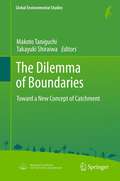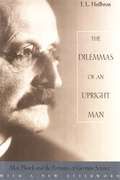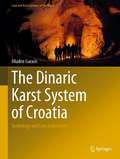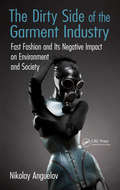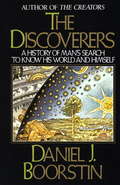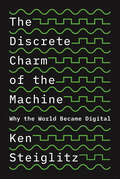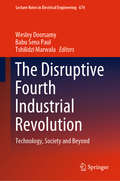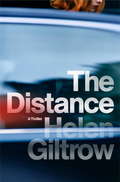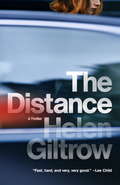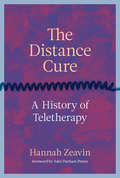- Table View
- List View
The Digital Revolution and the Coming of the Postmodern University
by Carl A. RaschkeIn recent years, the powerful social, cultural and economic changes wrought by digital technology have led many to forecast the end of the university as we know it. This book employs extensive research and case studies to explain why these predictions, even if perhaps somewhat premature, are on solid ground.The Digital Revolution and the Coming of the Postmodern University shows how the internet, high-speed electronic communications and personal computers necessitate a radical rethinking of what is meant by 'higher education'. The book calls into question both the traditionalist's scepticism about the benefits of new technology, and the corporate e-learning advocate's failure to grasp that education is more than what happens on a computer screen. The author provides concrete data and models for more democratic, restructured systems of instruction that not only take advantage of advanced learning technologies, but promote the globalisation of higher education.This is an essential read for anyone concerned about the future of higher education.
The Digital Rights Movement
by Hector PostigoThe movement against restrictive digital copyright protection arose largely in response to the excesses of the Digital Millennium Copyright Act (DMCA) of 1998. In The Digital Rights Movement, Hector Postigo shows that what began as an assertion of consumer rights to digital content has become something broader: a movement concerned not just with consumers and gadgets but with cultural ownership. Increasingly stringent laws and technological measures are more than incoveniences; they lock up access to our "cultural commons. " Postigo describes the legislative history of the DMCA and how policy "blind spots" produced a law at odds with existing and emerging consumer practices. Yet the DMCA established a political and legal rationale brought to bear on digital media, the Internet, and other new technologies. Drawing on social movement theory and science and technology studies, Postigo presents case studies of resistance to increased control over digital media, describing a host of tactics that range from hacking to lobbying. Postigo discusses the movement's new, user-centered conception of "fair use" that seeks to legitimize noncommercial personal and creative uses such as copying legitimately purchased content and remixing music and video tracks. He introduces the concept of technological resistance--when hackers and users design and deploy technologies that allows access to digital content despite technological protection mechanisms--as the flip side to the technological enforcement represented by digital copy protection and a crucial tactic for the movement.
The Digital Rights Movement: The Role of Technology in Subverting Digital Copyright (The Information Society Series)
by Hector PostigoThe evolution of activism against the expansion of copyright in the digital domain, with case studies of resistance including eBook and iTunes hacks.The movement against restrictive digital copyright protection arose largely in response to the excesses of the Digital Millennium Copyright Act (DMCA) of 1998. In The Digital Rights Movement, Hector Postigo shows that what began as an assertion of consumer rights to digital content has become something broader: a movement concerned not just with consumers and gadgets but with cultural ownership. Increasingly stringent laws and technological measures are more than incoveniences; they lock up access to our “cultural commons.”Postigo describes the legislative history of the DMCA and how policy “blind spots” produced a law at odds with existing and emerging consumer practices. Yet the DMCA established a political and legal rationale brought to bear on digital media, the Internet, and other new technologies. Drawing on social movement theory and science and technology studies, Postigo presents case studies of resistance to increased control over digital media, describing a host of tactics that range from hacking to lobbying.Postigo discusses the movement's new, user-centered conception of “fair use” that seeks to legitimize noncommercial personal and creative uses such as copying legitimately purchased content and remixing music and video tracks. He introduces the concept of technological resistance—when hackers and users design and deploy technologies that allows access to digital content despite technological protection mechanisms—as the flip side to the technological enforcement represented by digital copy protection and a crucial tactic for the movement.
The Digital Shopfloor- Industrial Automation in the Industry 4.0 Era: Performance Analysis and Applications (River Publishers Series In Automation, Control And Robotics Ser.)
by John Soldatos Oscar Lazaro Franco CavadiniIn today’s competitive global environment, manufacturers are offered with unprecedented opportunities to build hyper-efficient and highly flexible plants, towards meeting variable market demand, while at the same time supporting new production models such as make-to-order (MTO), configure-to-order (CTO) and engineer-to-order (ETO). During the last couple of years, the digital transformation of industrial processes is propelled by the emergence and rise of the fourth industrial revolution (Industry4.0). The latter is based on the extensive deployment of Cyber-Physical Production Systems (CPPS) and Industrial Internet of Things (IIoT) technologies in the manufacturing shopfloor, as well as on the seamless and timely exchange of digital information across supply chain participants. The benefits of Industry 4.0 have been already proven in the scope of pilot and production deployments in a number of different use cases including flexibility in automation, predictive maintenance, zero defect manufacturing and more. Despite early implementations and proof-of-concepts, CPPS/IIoT deployments are still in their infancy for a number of reasons, including:• Manufacturers’ poor awareness about digital manufacturing solutions and their business value potential, as well as the lack of relevant internal CPPS/IIoT knowledge.• The high costs that are associated with the deployment, maintenance and operation of CPPS systems in the manufacturing shopfloors, which are particularly challenging in the case of SME (Small Medium Enterprises) manufacturers that lack the equity capital needed to invest in Industry 4.0.• The time needed to implement CPPS/IIoT and the lack of a smooth and proven migration path from existing OT solutions.• The uncertainty over the business benefits and impacts of IIoT and CPPS technologies, including the lack of proven methods for the techno-economic evaluation of Industry4.0 systems. • Manufacturers’ increased reliance on external integrators, consultants and vendors. • The absence of a well-developed value chain needed to sustain the acceptance of these new technologies for digital automation.In order to alleviate these challenges, three European Commission funded projects (namely H2020 FAR-EDGE (http://www.far-edge.eu/), H2020 DAEDALUS (http://daedalus.iec61499.eu) and H2020 AUTOWARE (http://www.autoware-eu.org/)) have recently joined forces towards a “Digital Shopfloor Alliance”. The Alliance aims at providing leading edge and standards based digital automation solutions, along with guidelines and blueprints for their effective deployment, validation and evaluation. The present book provides a comprehensive description of some of the most representative solutions that offered by these three projects, along with the ways these solutions can be combined in order to achieve multiplier effects and maximize the benefits of their use. The presented solutions include standards-based digital automation solutions, following different deployment paradigms, such as cloud and edge computing systems. Moreover, they also comprise a rich set of digital simulation solutions, which are explored in conjunction with the H2020 MAYA project (http://www.maya-euproject.com/). The latter facilitate the testing and evaluation of what-if scenarios at low risk and cost, but also without disrupting shopfloor operations. As already outlined, beyond leading edge scientific and technological development solutions, the book comprises a rich set of complementary assets that are indispensable to the successful adoption of IIoT/CPPS in the shopfloor. The book is structured in three parts as follows: • The first part of the book is devoted to digital automation platforms. Following an introduction to Industry 4.0 in general and digital automation platforms in particular, this part presents the digital automation platforms of the FAR-EDGE, AUTOWARE and DAEDALUS projects. • The second part of the book focuses on the presentation of digital simulation and digital twins’ functionalities. These include information about the models that underpin digital
The Digital Transformation of Logistics: Demystifying Impacts of the Fourth Industrial Revolution (IEEE Press Series on Technology Management, Innovation, and Leadership)
by Mac Sullivan Johannes KernThe digital transformation is in full swing and fundamentally changes how we live, work, and communicate with each other. From retail to finance, many industries see an inflow of new technologies, disruption through innovative platform business models, and employees struggling to cope with the significant shifts occurring. This Fourth Industrial Revolution is predicted to also transform Logistics and Supply Chain Management, with delivery systems becoming automated, smart networks created everywhere, and data being collected and analyzed universally. The Digital Transformation of Logistics: Demystifying Impacts of the Fourth Industrial Revolution provides a holistic overview of this vital subject clouded by buzz, hype, and misinformation. The book is divided into three themed-sections: Technologies such as self-driving cars or virtual reality are not only electrifying science fiction lovers anymore, but are also increasingly presented as cure-all remedies to supply chain challenges. In The Digital Transformation of Logistics: Demystifying Impacts of the Fourth Industrial Revolution, the authors peel back the layers of excitement that have grown around new technologies such as the Internet of Things (IoT), 3D printing, Robotic Process Automation (RPA), Blockchain or Cloud computing, and show use cases that give a glimpse about the fascinating future we can expect. Platforms that allow businesses to centrally acquire and manage their logistics services disrupt an industry that has been relationship-based for centuries. The authors discuss smart contracts, which are one of the most exciting applications of Blockchain, Software as a Service (SaaS) offerings for freight procurement, where numerous data sources can be integrated and decision-making processes automated, and marine terminal operating systems as an integral node for shipments. In The Digital Transformation of Logistics: Demystifying Impacts of the Fourth Industrial Revolution, insights are shared into the cold chain industry where companies respond to increasing quality demands, and how European governments are innovatively responding to challenges of cross-border eCommerce. People are a vital element of the digital transformation and must be on board to drive change. The Digital Transformation of Logistics: Demystifying Impacts of the Fourth Industrial Revolution explains how executives can create sustainable impact and how competencies can be managed in the digital age - especially for sales executives who require urgent upskilling to remain relevant. Best practices are shared for organizational culture change, drawing on studies among senior leaders from the US, Singapore, Thailand, and Australia, and for managing strategic alliances with logistics service providers to offset risks and create cross-functional, cross-company transparency. The Digital Transformation of Logistics: Demystifying Impacts of the Fourth Industrial Revolution provides realistic insights, a ready-to-use knowledge base, and a working vocabulary about current activities and emerging trends of the Logistics industry. Intended readers are supply chain professionals working for manufacturing, trading, and freight forwarding companies as well as students and all interested parties.
The Digital Transformation of Product Formulation: Concepts, Challenges, and Applications for Accelerated Innovation
by Alix Schmidt Kristin WallaceIn competitive manufacturing industries, organizations embrace product development as a continuous investment strategy since both market share and profit margin stand to benefit. Formulating new or improved products has traditionally involved lengthy and expensive experimentation in laboratory or pilot plant settings. However, recent advancements in areas from data acquisition to analytics are synergizing to transform workflows and increase the pace of research and innovation. The Digital Transformation of Product Formulation offers practical guidance on how to implement data-driven, accelerated product development through concepts, challenges, and applications. In this book, you will read a variety of industrial, academic, and consulting perspectives on how to go about transforming your materials product design from a twentieth-century art to a twenty-first-century science. Presents a futuristic vision for digitally enabled product development, the role of data and predictive modeling, and how to avoid project pitfalls to maximize probability of success Discusses data-driven materials design issues and solutions applicable to a variety of industries, including chemicals, polymers, pharmaceuticals, oil and gas, and food and beverages Addresses common characteristics of experimental datasets, challenges in using this data for predictive modeling, and effective strategies for enhancing a dataset with advanced formulation information and ingredient characterization Covers a wide variety of approaches to developing predictive models on formulation data, including multivariate analysis and machine learning methods Discusses formulation optimization and inverse design as natural extensions to predictive modeling for materials discovery and manufacturing design space definition Features case studies and special topics, including AI-guided retrosynthesis, real-time statistical process monitoring, developing multivariate specifications regions for raw material quality properties, and enabling a digital-savvy and analytics-literate workforce This book provides students and professionals from engineering and science disciplines with practical know-how in data-driven product development in the context of chemical products across the entire modeling lifecycle.
The Digital Transformation of the Automotive Industry: Catalysts, Roadmap, Practice
by Uwe WinkelhakeBuilding on his decades of experience as a consultant and project manager in the automotive industry, the author develops comprehensive and pragmatic recommendations for action regarding the digital transformation of the automotive and supplier industries. At the heart is the transition from a vehicle-focused to a mobility-oriented business model. Based on the catalysts of the digital change, four digitizsation fields are structured, and a roadmap for their transformation is presented. The topics of comprehensive change in corporate culture and an agile and efficient information technology are covered in detail as vital success factors. Selected practical examples of innovative digitizsation projects provide additional ideas and impulses. An outlook on the automotive industry in the year 2040 completes the discourse.
The Digital Transformation of the Automotive Industry: Catalysts, Roadmap, Practice
by Uwe WinkelhakeThis book provides comprehensive and pragmatic recommendations for action for the automotive and supplier industry, which has been changing ever more rapidly in recent years. China has developed into the leading market for e-mobility and for the use of autonomous robotaxis, AI and data. The established manufacturers have to change much more quickly based on clear objectives in order not to lose touch and to still be able to achieve the Paris climate goals. The industry is changing comprehensively from a vehicle-focused to a mobility-oriented business model. More and more processes, even entire business areas, will run automatically based on AI and new technologies will change sales and aftersales structures. More and more data is being created, which also enables new, profitable products. The switch to e-vehicles with an appropriate charging environment, the use of mobility services instead of car ownership, climate-neutral production and the circular economy must be addressed more quickly. The third edition of the book provides complete information on the digital transformations that are still absolutely necessary and taking into account the latest developments revised edition comprehensive and pragmatic answers to current questions: How should new technologies be used in a structured manner and where will AI lead to significant changes? How should the transformation be approached and with what key topics? The outlook beyond 2040 at the end of the book has been expanded and the expected changes in the world of work are considered, especially from an AI perspective. Regarding the digital transformations that are still absolutely necessary and taking into account the latest developments, the book, now in its third completely revised edition, provides comprehensive and pragmatic answers to current questions: How should new technologies be used in a structured manner and where will AI lead to significant changes? How should the transformation be approached and with what key topics? The outlook beyond 2040 at the end of the book has been expanded and the expected changes in the world of work are considered, especially from an AI perspective.
The Digital Transformation of the Public Sphere
by Athina Karatzogianni Dennis Nguyen Elisa SerafinelliBringing together contributions from the fields of sociology, media and cultural studies, arts, politics, science and technology studies, political communication theory and popular culture studies, this volume engages both with theoretical debates and detailed empirical studies, showcasing how the public sphere is transformed by digital media, and in turn how this digital public sphere shapes and is shaped by debates surrounding crisis, conflict, migration and culture. Case studies from Bulgaria, Nigeria, China, Greece, Italy, Cyprus, UK, Mexico and India are discussed in detail.
The Digital Twin
by Roberto Minerva Noel Crespi Adam T. DrobotThe Digital Twin is crucial and timely for positively affecting how we work, live, and play. It eliminates the gap between experimentation and learning by bridging real and virtual worlds in a powerful methodology, making significant headway in conquering previously unsolvable problems and challenges. Digital Twins are made possible by four widely deployed infrastructures for connectivity, computing, digital storage, and sources of digital data. The Digital Twin provides insights, paths to innovation, efficient production of goods, improved delivery of services, better experiences and entertainment, and new business models. Investing in Digital Twins is one of the most valuable ways to create sustainable paths to the future. The Digital Twin book is the most comprehensive work on the subject to date. It brings together top practitioners, technical experts, analysts, and academics to explore and discuss the concept of the Digital Twin, its history, evolution, and the profound impact across sectors of the global economy. The book addresses the business value, technological underpinnings, lessons learned from implementations, resources for success, practical approaches for implementation, and illustrative use cases. It makes the case for why we believe that Digital Twins will fundamentally transform major industries and enable us to fulfill important societal goals. The book is recommended for key decision makers, senior executives, technical leaders, researchers, and students.
The Digital Twin of Humans: An Interdisciplinary Concept of Digital Working Environments in Industry 4.0
by Günter W. Maier Eckhard Steffen Iris Gräßler Daniel RoesmannThis book provides an interdisciplinary concept of digital working environments in industry 4.0 to enable the implementation of the digital twin of humans.Information and communication technology is penetrating all areas of daily life at a rapid pace in private and professional areas. These technologies enable companies to aggregate huge volumes of data. Collected personal data of employees creates the opportunity of a digital representation of the human being itself, that is conformant with the definition of a digital twin. These digital twins of humans include selected characteristics and behaviour of the humans, that are linked to models, information, and data. According to existing trend studies, the digital twin of humans is a technology that will have a significant impact on the economy, society, and people. It is important to consider the regulatory framework for the use of personal data and threats of misuse.This book will be of use to researchers and professionals in industry.
The Digital War: How China's Tech Power Shapes the Future of AI, Blockchain and Cyberspace
by Winston MaWhat new directions in China’s digital economy mean for us all China is the largest homogenous digital market on Earth: unified by language, culture, and mobile payments. Not only a consumer market of unrivaled size, it’s also a vast and hyperactive innovation ecosystem for new technologies. And as China’s digital economy moves from a consumer-focused phase to an enterprise-oriented one, Chinese companies are rushing to capitalize on ways the newer wave of tech—the Internet of Things, AI, blockchain, cloud computing, and data analytics (iABCD)—can unlock value for their businesses from non-traditional angles. In China’s Data Economy, Winston Ma—investment professional, capital markets attorney, adjunct professor of digital economy, and bestselling author—details the profound global implications of this new direction, including how Chinese apps for services such as food delivery expand so quickly they surpass their U.S. models within a couple of years, and how the sheer scale and pace of Chinese innovation might lead to an AI arms race in which China and the U.S. vie aggressively for leadership. How China’s younger netizens participate in their evolving digital economy as consumers, creators, and entrepreneurs Why Online/Office (OMO, Online-merge-with-Offline) integration is viewed as the natural next step on from the O2O (Online-to-Offline) model used in the rest of the world The ways in which traditional Chinese industries such as retail, banking, and insurance are innovating to stay in the game What emerging markets can learn from China as they leapfrog past the personal computer age altogether, diving straight into the mobile-first economy Anyone interested in what’s nex
The Digital and Its Discontents (Electronic Mediations #62)
by Alexander R. Galloway Aden EvensA groundbreaking critique of the digital world that analyzes its universal technological foundations Whence that nagging sense that something in the digital is amiss—that, as wonderful as our devices are, time spent on smartphones and computers leaves us sour, enervated, alienated? The Digital and Its Discontents uniquely explains that worry and points us toward a more satisfying relationship between our digital lives and our nondigital selves, one that requires a radical change in the way we incorporate technology into our lives. Aden Evens analyzes universal technological principles—in particular, the binary logic—to show that they encourage certain ways of thinking while making others more challenging or impossible. What is out of reach for any digital machine is contingency, the ontological principle that refuses every rule. As humans engage ourselves and our world ever more through digital machines, we are losing touch with contingency and so banishing from our lives the accidental and unexpected that fuel our most creative and novel possibilities for living. Taking cues from philosophy rather than cultural or media theory, Evens argues that the consequences of this erosion of contingency are significant yet often overlooked because the same values that make the digital seem so desirable also make contingency seem unimportant—without contingency the digital is confined to what has already been thought, and yet the digital&’s ubiquity has allowed it to disguise this inherent sterility. Responsive only to desires that meet the demands of its narrow logic, the digital requires its users to practice those same ideological dictates, instituting a hegemony of thought and value sustained by the pervasive presence of digital mechanisms. Interweaving technical and philosophical concepts, The Digital and Its Discontents advances a powerful and urgent argument about the digital and its impact on our lives. Retail e-book files for this title are screen-reader friendly.
The Digitalisation of Anti-Corruption in Brazil: Scandals, Reforms, and Innovation (ISSN)
by Fernanda OdillaThis book investigates how digital technologies, such as social media and artificial intelligence, can contribute to combatting corruption in Brazil.Brazil, with its long history of scandals and abundant empirical data on digital media usage, serves as a perfect case study to trace the development of bottom-up and top-down digital anti-corruption technologies and their main features. This book highlights the connections between anti-corruption reforms and the rapid implementation of innovative solutions, primarily developed by tech-savvy public officials and citizens committed to anti-corruption efforts. The book draws on interviews with experts, activists and civil servants, as well as open-source materials and social media data to identify key actors, their practices, challenges and limitations of anti-corruption technologies. The result is a thorough analysis of the process of digitalisation of anti-corruption in Brazil, with a theoretical framework which can also be applied to other countries. The book introduces the concept of “integrity techies” to encompass social and political actors who develop and facilitate anti-corruption technologies, and discusses different outcomes and issues associated with digital innovation in anti-corruption.This book will be a key resource for students, researchers and practitioners interested in technologies and development in Brazil and Latin America, as well as corruption and anti-corruption studies more broadly.
The Dilemma of Boundaries
by Makoto Taniguchi Takayuki ShiraiwaWater circulates continuously and seamlessly on Earth with little regard for the boundaries we draw. There are natural boundaries as between land and ocean and surface and subsurface environments, as well as human or demographic boundaries between nations, cultures, and religions. Although considered necessary by societies, these human-created boundaries disrupt natural water circulation, leading to serious water-related environmental problems. The dilemma of how to manage water beyond our boundaries remains, and nations have different ways and means of controlling each form of water, whether as vapor, surface water, groundwater, or seawater. Recent findings on the interaction of water from land, oceans, and the atmosphere encourage researchers to undertake collaborative work that goes beyond the boundaries of each discipline, be it oceanography, surface and subsurface hydrology, climatology, or glaciology. Drawing on all these fields, the book focuses on two major boundaries: that between surface water and ground water, and that between terrestrial water and ocean water. This comprehensive work is of great value to experts in academia, international organizations, consulting firms, water resources, fisheries, and urban development planning agencies.
The Dilemmas of an Upright Man: Max Planck and the Fortunes of German Science, With a New Afterword
by J. L. HeilbronIn this moving and eloquent portrait, Heilbron describes how the founder of quantum theory rose to the pinnacle of German science. He shows how Planck suffered morally and intellectually as his lifelong habit of service to his country and to physics was confronted by the realities of World War I and the brutalities of the Third Reich.
The Dinaric Karst System of Croatia: Speleology and Cave Exploration (Cave and Karst Systems of the World)
by Mladen GarasicThis book offers readers a thorough introduction to the Dinaric Karst System in Croatia. As the first comprehensive book on the country’s caves and karst, it presents a wealth of fascinating photographs from its karst underground. To date, ca. 12,000 caves and pits have been confirmed in Croatia, approximately 35% of which contain constant groundwater. Knowing the amount, direction and quality of groundwater that has been discovered in caves of the Croatian karst allows us to predict with greater certainty the hydrogeological situation of some karst areas where no special drilling or borehole measurements were performed.In the process of building highways in the country’s karst regions over the last thirty years, thousands of caverns (speleological features without natural entrances) were discovered and thoroughly explored. All of them were geologically mapped, surveyed, and photographed in detail. Extensive research was systematically carried out in Croatian karst regions on sections of roads, highways, cuttings, slides, tunnels, bridge foundations, viaducts, etc., while creating ca. 800 kilometers of highways (such as the Zagreb-Rijeka highway, Zagreb-Split-Dubrovnik highway, Y-Ipsilon of Istria semi-highway, Rijeka-Rupa highway, Zagreb-Zadar semi-highway, and the Rijeka bypass). Some of these caverns contain major chambers like in the “Sveti Rok” tunnel and in some of them, like in the “Vrata” tunnel, it was even necessary to build a bridge. This bridge is the longest one in the world built in a tunnel over a cavern.The book describes this and many more features of the cave exploration of the Dinaric Karst System of Croatia, making it a valuable resource for researchers, engineers, cavers, and all other readers interested in karst.
The Dinosaur Expert (Mr. Tiffin's Classroom Series)
by Margaret McNamaraJoin Mr. Tiffin and his students on a trip to a natural history museum and learn all about dinosaurs and the scientists who discovered them!Mr. Tiffin and his students are back in another picture book, and this time the focus is on dinosaur-loving Kimmy. During a field trip to the natural history museum, Kimmy is thrilled to share what she knows about the Stegosaurus and the Archaeopteryx and even the ginormous Titanosaurus. That changes when one of her classmates questions whether girls can be paleontologists. Kimmy starts to feel shy. What if they can't? What if no one wants to hear what she has to say? It will take some help from Mr. Tiffin--and from a famous scientist--for Kimmy to find her voice again.Join Mr. Tiffin's class as they learn about dinosaurs big and small, feathered and scaly, winged and ocean-dwelling. And root for Kimmy, the dinosaur expert . . . who might just learn something about herself.
The Dirty Side of the Garment Industry: Fast Fashion and Its Negative Impact on Environment and Society
by Nikolay AnguelovWhen thinking about lowering or changing consumption to lower carbon footprints, the obvious offenders come easily to mind: petroleum and petroleum products, paper and plastic, even food. But not clothes. Although the clothing industry is the second largest polluter after agriculture, most consumers do not think of clothes as a source of environmen
The Discoverers
by Daniel J. BoorstinAn original history of man's greatest adventure: his search to discover the world around him. In the compendious history, Boorstin not only traces man's insatiable need to know, but also the obstacles to discovery and the illusion that knowledge can also put in our way. Covering time, the earth and the seas, nature and society, he gathers and analyzes stories of the man's profound quest to understand his world and the cosmos.
The Discrete Charm of the Machine: Why the World Became Digital
by Ken SteiglitzThe genesis of the digital idea and why it transformed civilizationA few short decades ago, we were informed by the smooth signals of analog television and radio; we communicated using our analog telephones; and we even computed with analog computers. Today our world is digital, built with zeros and ones. Why did this revolution occur? The Discrete Charm of the Machine explains, in an engaging and accessible manner, the varied physical and logical reasons behind this radical transformation.The spark of individual genius shines through this story of innovation: the stored program of Jacquard’s loom; Charles Babbage’s logical branching; Alan Turing’s brilliant abstraction of the discrete machine; Harry Nyquist’s foundation for digital signal processing; Claude Shannon’s breakthrough insights into the meaning of information and bandwidth; and Richard Feynman’s prescient proposals for nanotechnology and quantum computing. Ken Steiglitz follows the progression of these ideas in the building of our digital world, from the internet and artificial intelligence to the edge of the unknown. Are questions like the famous traveling salesman problem truly beyond the reach of ordinary digital computers? Can quantum computers transcend these barriers? Does a mysterious magical power reside in the analog mechanisms of the brain? Steiglitz concludes by confronting the moral and aesthetic questions raised by the development of artificial intelligence and autonomous robots.The Discrete Charm of the Machine examines why our information technology, the lifeblood of our civilization, became digital, and challenges us to think about where its future trajectory may lead.
The Disruptive Fourth Industrial Revolution: Technology, Society and Beyond (Lecture Notes in Electrical Engineering #674)
by Tshilidzi Marwala Wesley Doorsamy Babu Sena PaulThe book explores technological advances in the fourth industrial revolution (4IR), which is based on a variety of technologies such as artificial intelligence, Internet of Things, machine learning, big data, additive printing, cloud computing, and virtual and augmented reality. Critically analyzing the impacts and effects of these disruptive technologies on various areas, including economics, society, business, government, labor, law, and environment, the book also provides a broad overview of 4IR, with a focus on technologies, to allow readers to gain a deeper understanding of the recent advances and future trajectories. It is intended for researchers, practitioners, policy-makers and industry leaders.
The Distance
by Helen GiltrowA dark, ultra-contemporary and relentlessly paced debut thriller about a London society woman trying to put her secret criminal past behind her--and the hit man who comes to her with an impossible job she can't refuse. Charlotte Alton is an elegant socialite. But behind the locked doors of her sleek, high-security apartment in London's Docklands, she becomes Karla. Karla's business is information. Specifically, making it disappear. She's the unseen figure who, for a commanding price, will cover a criminal's tracks. A perfectionist, she's only made one slip in her career: several years ago she revealed her face to a man named Simon Johanssen, an ex-special forces sniper turned killer-for-hire. After a mob hit went horrifically wrong, Johanssen needed to disappear, and Karla helped him. He became a regular client, and then one day, she stepped out of the shadows for reasons unclear to even herself. Now, after a long absence, Johanssen has resurfaced with a job, and he needs Karla's help again. The job is to take out an inmate--a woman--inside an experimental prison colony. But there's no record the target ever existed. That's not the only problem: the criminal boss from whom Johanssen has been hiding is incarcerated there. That doesn't stop him. It's Karla's job to get him out alive, and to do that she must uncover the truth. Who is this woman? Who wants her dead? Is the job a trap for Johanssen or for her? But every door she opens is a false one, and she's getting desperate to protect a man--a killer--to whom she's inexplicably drawn. Written in stylish, sophisticated prose, The Distance is a tense and satisfying debut in which every character, both criminal and law-abiding, wears 2 faces, and everyone is playing a double game.
The Distance
by Helen GiltrowA dark, ultra-contemporary, and relentlessly paced debut thriller about a London society woman trying to put her secret criminal past behind her, and the hit man who comes to her with an impossible job she can't refuse.Charlotte Alton is an elegant socialite. But behind the locked doors of her sleek, high-security apartment in London's Docklands, she becomes Karla. Karla's business is information. Specifically, making it disappear. She's the unseen figure who, for a commanding price, will cover a criminal's tracks. A perfectionist, she's only made one slip in her career--several years ago she revealed her face to a man named Simon Johanssen, an ex-special forces sniper turned killer-for-hire. After a mob hit went horrifically wrong, Johanssen needed to disappear, and Karla helped him. He became a regular client, and then, one day, she stepped out of the shadows for reasons unclear to even herself. Now, after a long absence, Johanssen has resurfaced with a job, and he needs Karla's help again. The job is to take out an inmate--a woman--inside an experimental prison colony. But there's no record the target ever existed. That's not the only problem: the criminal boss from whom Johanssen has been hiding is incarcerated there. That doesn't stop him. It's Karla's job to get him out alive, and to do that she must uncover the truth. Who is this woman? Who wants her dead? Is the job a trap for Johanssen or for her? But every door she opens is a false one, and she's getting desperate to protect a man--a killer--to whom she's inexplicably drawn. Written in stylish, sophisticated prose, The Distance is a tense and satisfying debut in which every character, both criminal and law-abiding, wears two faces, and everyone is playing a double game.
The Distance Cure: A History of Teletherapy
by Hannah ZeavinPsychotherapy across distance and time, from Freud&’s treatments by mail to crisis hotlines, radio call-ins, chatbots, and Zoom sessions.Therapy has long understood itself as taking place in a room, with two (or more) people engaged in person-to-person conversation. And yet, starting with Freud&’s treatments by mail, psychotherapy has operated through multiple communication technologies and media. These have included advice columns, radio broadcasts, crisis hotlines, video, personal computers, and mobile phones; the therapists (broadly defined) can be professional or untrained, strangers or chatbots. In The Distance Cure, Hannah Zeavin proposes a reconfiguration of the traditional therapeutic dyad of therapist and patient as a triad: therapist, patient, and communication technology. Zeavin tracks the history of teletherapy (understood as a therapeutic interaction over distance) and its metamorphosis from a model of cure to one of contingent help. She describes its initial use in ongoing care, its role in crisis intervention and symptom management, and our pandemic-mandated reliance on regular Zoom sessions. Her account of the &“distanced intimacy&” of the therapeutic relationship offers a powerful rejoinder to the notion that contact across distance (or screens) is always less useful, or useless, to the person seeking therapeutic treatment or connection. At the same time, these modes of care can quickly become a backdoor for surveillance and disrupt ethical standards important to the therapeutic relationship. The history of the conventional therapeutic scenario cannot be told in isolation from its shadow form, teletherapy. Therapy, Zeavin tells us, was never just a &“talking cure&”; it has always been a communication cure.
